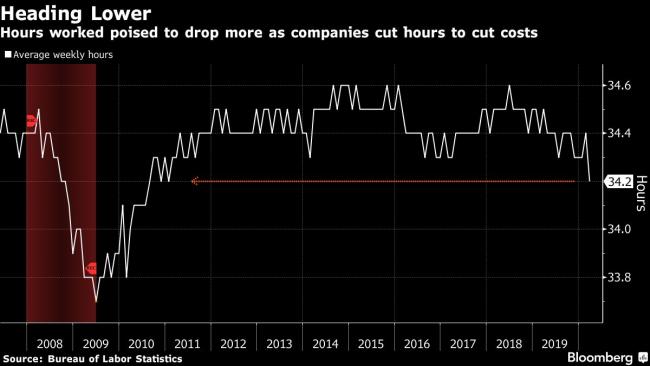(Bloomberg) -- In one word: heartbreaking.
Friday’s U.S. jobs report is forecast to show employers slashed about 21.7 million jobs in April, nearly erasing a decade of job gains in a single month as the country shut down to control the spread of the coronavirus.
That’s 27 times the worst monthly decline during the 2007-2009 recession and about 11 times the previous record decline in September 1945, when the nation demobilized with the end of World War II.
“This might be the worst macroeconomic data report in U.S. history,” said James Sweeney, chief economist at Credit Suisse (SIX:CSGN) Group AG.
The unemployment rate -- which was at a 50-year low just a few months ago -- may surge to 16%, the highest level by far in records dating back to the 1940s. With millions more Americans filing for unemployment benefits in recent weeks, the jobless rate is likely to keep climbing in May.
Read More:
- U.S. Jobless Claims Top 3 Million, With Little Relief in Sight
- Minorities Are Among Groups Seeing a Decade’s Job Gains Vanish
- Fed’s Kashkari Sees ‘Devastating’ Unemployment and Long Recovery
- Layoffs Start Turning From Temporary to Permanent Across America
The Covid-19 pandemic stopped the longest-running economic expansion in its tracks as state governments quickly imposed measures to protect public health -- closing restaurants to dine-in customers and shuttering offices, factories and anything else deemed non-essential.
The Labor Department’s headline figures due at 8:30 a.m. in Washington will tell a huge part of the story. But other numbers will detail which workers are feeling the most financial pain -- through job losses or reduced hours -- and provide hints about how quickly the once-smooth running American jobs engine will recover.
Industry Breakdown
The sheer volume of jobless claims alone -- 33.5 million in the seven weeks through May 2 -- show job losses have been extensive. Hourly workers, particularly those employed at restaurants and hotels, have been hit especially hard, but this report will offer a fuller picture of the size and scope of the payroll reductions across industries.
“The breadth of the job losses will be important,” said Michelle Meyer, head of U.S. economics at Bank of America Corp (NYSE:BAC).
The more the losses are concentrated in areas like accommodation, food services and retail, the more it would look like “an isolated shock,” she said. However, widespread cuts in industries less directly hit by Covid-19 will show “the extent to which the recession has rippled into the broader economy.”
Data from the ADP (NASDAQ:ADP) Research Institute on Wednesday already indicated the job losses are broad-based. All categories except company management and education saw declines in payrolls.
Hourly Earnings
The Bureau of Labor Statistics calculates average hourly earnings through a basic equation of dividing total payroll costs by total hours worked. When done on a national scale, the composition of the jobs market can impact the figure.
Layoffs have been particularly extreme within low-wage industries such as leisure and hospitality. So a greater share of workers employed in higher-pay sectors would result in a more pronounced pickup in average earnings. While the median estimate calls for a 0.4% increase from a month earlier, some economists see average hourly earnings jumping by as much as 5-6%.
Hours Worked
For employees fortunate enough to escape widespread layoffs, many are now working fewer days and hours. Even though their wage rates may be the same, reduced hours translates to less take-home pay. The severity of the drop in average weekly hours will offer insight into the degree of financial stress those still employed are facing.
U-6 Rate
The traditional unemployment rate (known as the U-3 rate) doesn’t capture those who have stopped looking for a job.
The so-called U-6 rate will offer a more accurate picture of how the pandemic is ripping through the once-strong labor market. The underemployment rate includes those who have quit looking for a job because they’re discouraged about their prospects -- something that may be a common theme during the shutdowns -- and people working part-time but desiring a full workweek.
Temporarily Unemployed
The number of unemployed people on temporary layoff surged by a record 131% in March to 1.85 million. That means people without a job temporarily -- such as those furloughed -- accounted for 77% of the total increase in unemployed Americans.
The BLS said last month the figure would have been even higher if not for a technical mistake in survey responses. The agency is adding coronavirus-specific questions with the May report, due in early June.
With many workers still attached to their employers, there’s a greater chance they will return to their jobs when the nation reopens.
“In the Great Depression, the vast majority of job losses were permanent. Today the vast majority of job losses are temporary,” said Mark Vitner, senior economist at Wells Fargo (NYSE:WFC) & Co. But, “I don’t think we get back to 100% for at least a year, 18 months, and we’re not going to need as many workers if we’re not back at 100%.”
That may mean even if the unemployment rate sharply drops to something like 8% as the economy turns back on, it will be a very slow descent back to the pre-Covid level, Bank of America’s Meyer said.
©2020 Bloomberg L.P.
